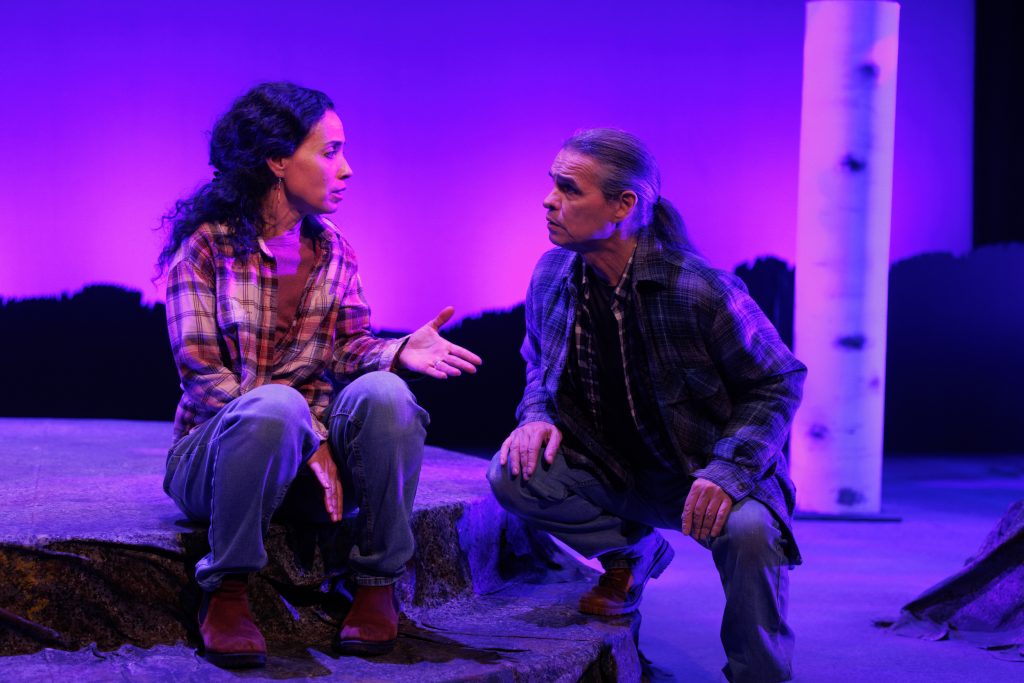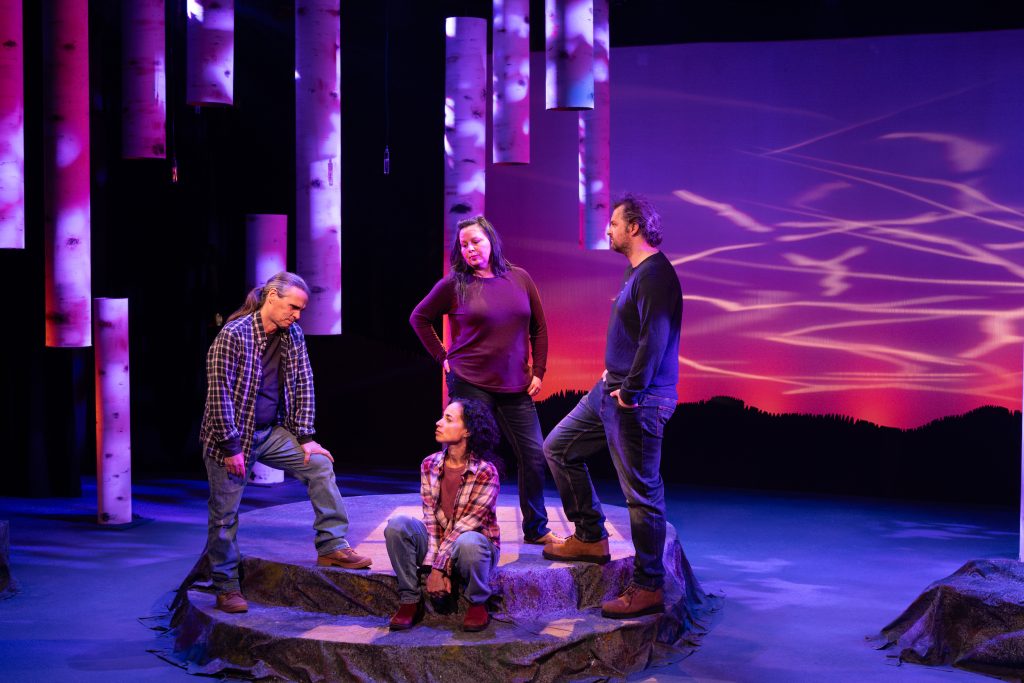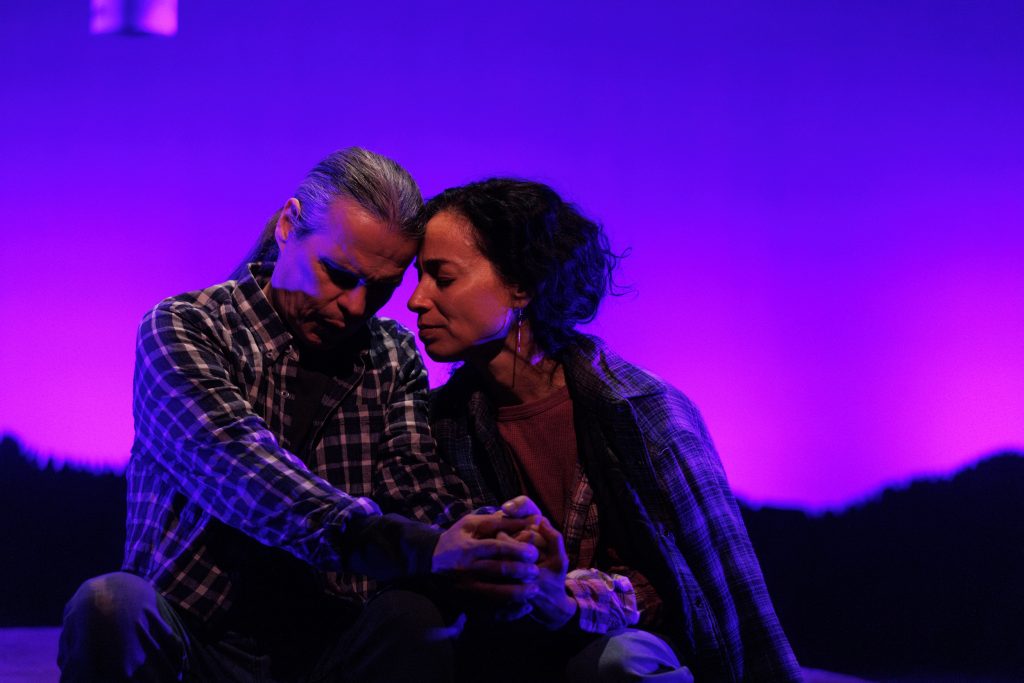
Credit: Sarah Race Photography
Firehall Arts Centre to April 28, 2024
Tickets from $30 at 604-689-0926 or www.firehallartscentre.ca
Posted April 24, 2024
When there is a split second of complete silence after the curtain falls, followed by applause, you know something has happened in the theatre. Heartbreak, heartache and healing is where Métis playwright Keith Barker takes us in This Is How We Got Here.
When considering how to review this Firehall production, directed by Donna Spencer and Lisa Cooke Ravensbergen, I wondered how those in the audience who have been touched by a loved one’s suicide would respond. There were tears.
For those of us who have the great fortune of never having had to face such unbearable grief, This Is How We Got Here is a window into what it takes to get through it.

Set design: Kimira Reddy. Lighting design: Rebekah Johnson. Credit: Sarah Race Photography
It is the one year anniversary of the death by suicide of Craig, young adult son of Lucille (Tasha Faye Evans) and Paul (Gordon Patrick White), and nephew of Liset (Ravensbergen) and Jim (Darcey Johnson). Lucille and Paul’s marriage has not survived Craig’s suicide; Lucille has moved in with her sister Liset.
Lucille is broken, unable to move on, plagued by guilt; “I’m his mother. I should have seen it.” Paul is also devastated and feels he failed his son, “a gentle” kid who never took to hockey or hunting or other ‘manly’ pursuits that Paul tried to get him interested in. The inference is that Craig was gay and in a far northern Ontario community the stigma attached to homosexuality was – and perhaps still is – unspeakable.
While no one talks about Craig’s possible sexual preference, a protracted and almost funny argument between Jim and Paul offers a clue. The guys fight over the term ‘fruit’, each accusing the other of being one. Serious offence is taken by both but Jim offers what he feels is the clinching argument: “Bein’ gay is a sin”. Although no suicide note was left, we assume Craig being gay led to him taking his life.

Credit: Sarah Race Photography
Threaded through the play is the myth of a magic fox who loved telling stories. But one day he ran out of stories and knew that if he didn’t come up with a story before sunset, he feared he would never tell stories again. Interspersed between Liset, Jim, Paul and Lucille’s story, the four characters relate the myth in a direct address to the audience. When Lucille encounters a fox in her sister’s garden reality and myth converge.
Playwright Barker lifts the play from deepest sorrow with ridiculous marital bickering between outspoken Liset and goofy Jim, and macho ‘guy talk’ between Jim and Paul. Ravensbergen is so natural in the role you’d swear you know someone just like Liset. Johnson is, for the most part, big and goofy as Jim but when the story calls on him to go deep, he does it – and he takes us with him. It’s harrowing.
White is wound so tight as Paul – and rightly so – that it seems he might implode at any moment while Evans, as Lucille, is so fragile you feel she might break right there on the Firehall stage.

Credit: Sarah Race Photography
Kimira Reddy’s set is lovely: a couple of dozen white birch tree trunks are suspended from the ceiling, backed by a big, beautiful sky gorgeously lit by Rebekah Johnson. It’s stunning.
This is a tough play to watch. We can only imagine the pain a child’s suicide causes his or her parents. The grief. The guilt. The why. The ‘if-onlys’. I could not help but think of the countless parents up north who experience the suicides of their children. Whole communities devastated. Whole communities losing the next generation.
Fortunately, This Is How We Got Here takes Lucille and Paul – and us – to a place of healing. Whether we buy into the mythical storytelling fox or not, we know that stories are what bind us and through them, we can find solace.

